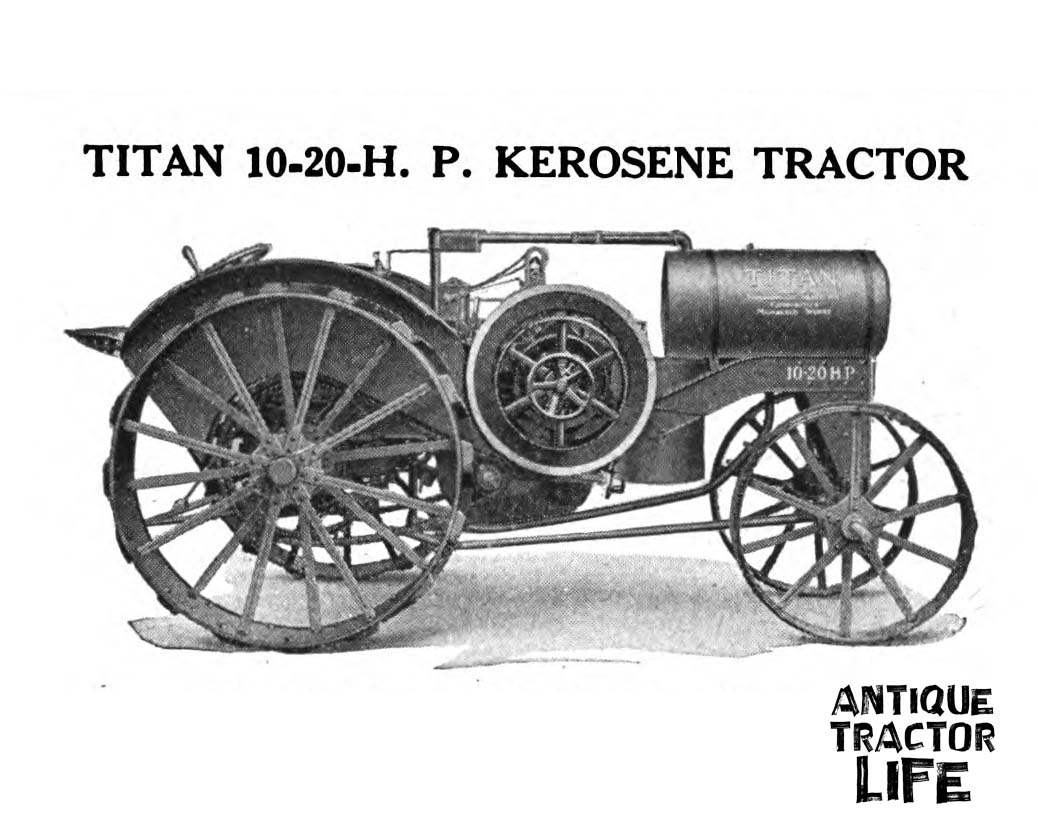
Of all tractors built by International Harvester before the introduction of the Farmall , the 10-20 Titan is the most prolific remnant. From its introduction in 1915 until final production in 1922, it went through several different variations including changes to carburetor, fenders, air-cleaner, tractor platform, frame, and cooling tank.
Only a few tractors were built in 1915. These tractors used igniters with make and brake ignition, unlike the final design that uses spark plugs with high-tension magneto. It’s believed that International Harvester destroyed or dismantled all the igniter style tractors because none of these exist today.
By the end of production in 1922 a total of 78,363 International Harvester 10-20 Titan tractors were built.
Tractor Information
The 10-20 Titan is a kerosene-burning light tractor, designed for all drawbar and belt work requirements on the average farm.
Power Plant: Twin-cylinder, valves in head, enclosed crank, oil-burning engine, built in units so that one section can be removed at a time, exposing a considerable part of the engine for examination without detaching numberless small parts.
Governor: Fly-ball, throttling governor, running in enclosed case.
Ignition: Jump spark. The operating current is supplied by a built-in high-tension magneto, with accelerator for starting -no batteries required.
Mixer: Special design, handling kerosene, distillate down to 39 degrees Baume, as well as gas oil, solar oil, motor spirits, naphthal, and gasoline.
Cooling System: Water cooled, circulating from a tank holding 39 gallons.
Lubrication: All working parts including rear truck bearings are oiled by force feed lubricators.
Transmission: Two-speeds ahead and one reverse by sliding gear transmission, controlled by one lever. The gears run in oil and our entirely enclosed. Forward speeds, 1.85 miles, 2.50 miles per hour. Reverse, 2.50 miles per hour.
Double Chain Drive: Chain drive to both real wheels, eliminating gears, giving a more even and flexible distribution of power than by any other system.
Steering: Automotive style with hand wheel and specially designed steering knuckle, making control positive and easy under all conditions.
Brake: Foot power brake by contracting bands acting on both rear wheels. Equipped with ratchet lock for blocking.
Specifications
- 10 horsepower on the drawbar
- 20 horsepower on the belt
- Speed of the motor is 500 revolutions per minute (R.P.M.)
- Two cylinder engine, tank cooled
- Fuel – burns both kerosene or gasoline
- Two forward speeds 1.85 and 2.50 miles per hour
- One reverse speed at 2.50 miles per hour
- Total length (with seat) is 147 inches
- Total width is 60 inches
- Total height is 66 3/4 inches
- Weight is 5,225 pounds
About International Harvester
International Harvester was a prominent American manufacturer of agricultural machinery, construction equipment, trucks, and household appliances. Founded in 1902 through the merger of several companies, including the McCormick Harvesting Machine Company and the Deering Harvester Company, International Harvester played a vital role in shaping the agricultural and industrial landscape of the United States.
The company became known for its innovative farm equipment, such as tractors, combines, and plows, contributing significantly to the mechanization of agriculture. International Harvester also ventured into the production of trucks and construction equipment, solidifying its presence in various sectors.
International Harvester went through significant changes over the years and ultimately evolved into a different entity. In 1985, International Harvester, facing financial difficulties and seeking to focus on its more profitable segments, sold the agricultural and construction equipment divisions to Tenneco Inc. In 1986, International Harvester rebranded the remaining portion of the company, primarily consisting of the truck and engine manufacturing divisions, as Navistar International Corporation.
Navistar continued to be a major player in the production of trucks, buses, and engines, while the agricultural and construction equipment divisions were no longer under the International Harvester umbrella. Over the subsequent years, Navistar faced various challenges, including financial struggles and legal issues related to engine technologies. In the early 2020s, Navistar agreed to be acquired by TRATON SE, a subsidiary of the Volkswagen Group, marking another chapter in the company’s history.

0